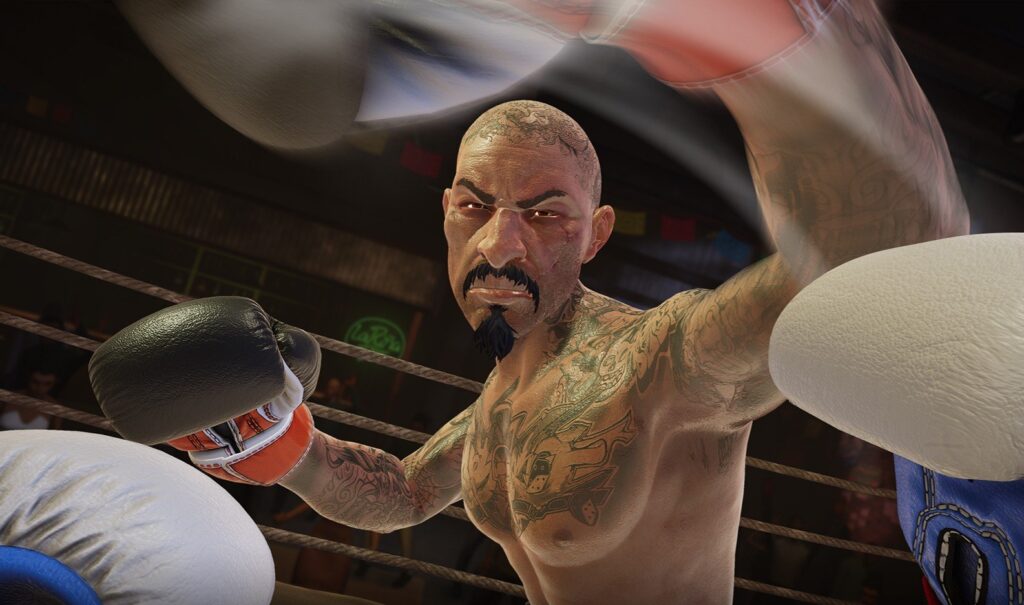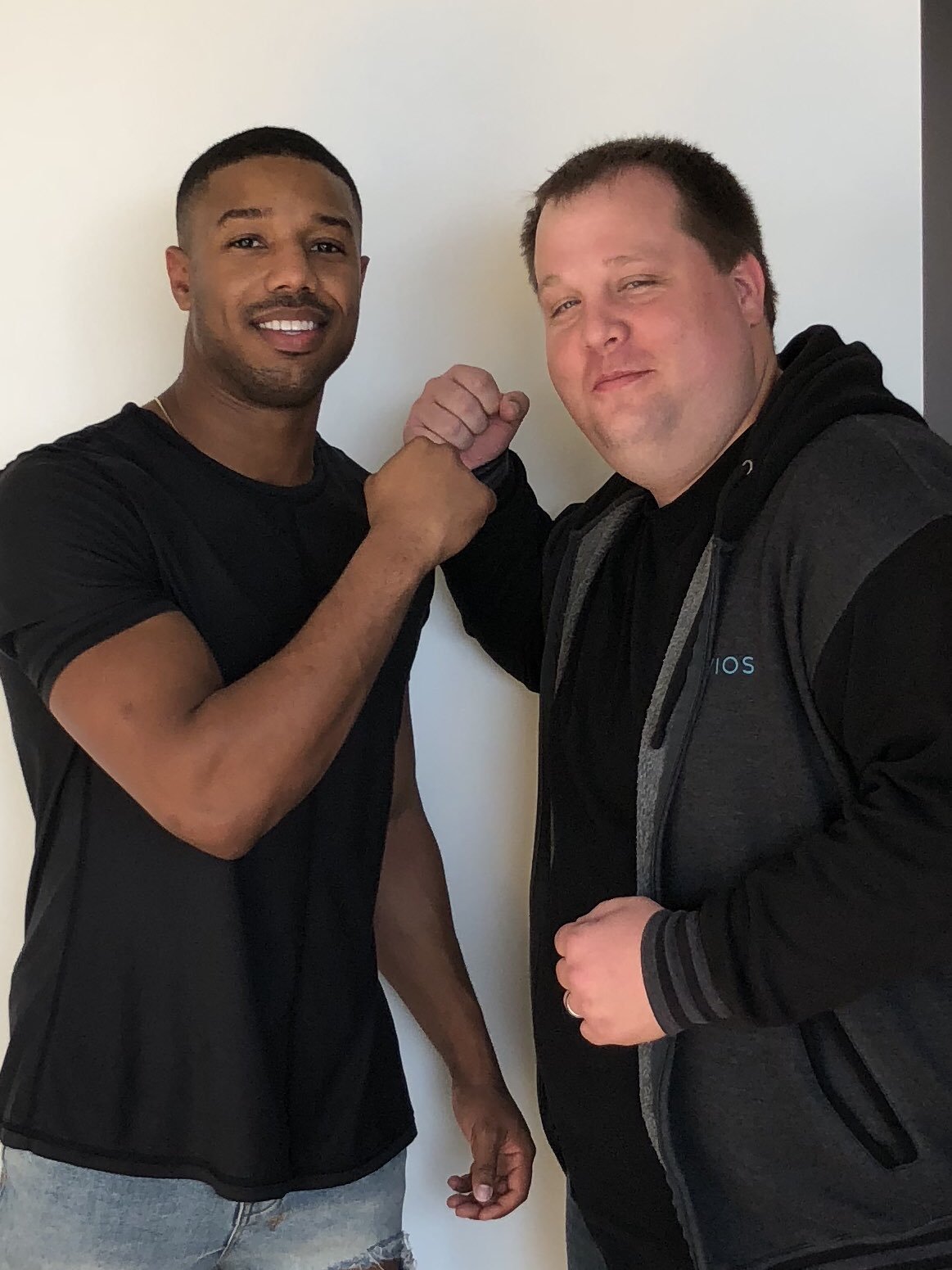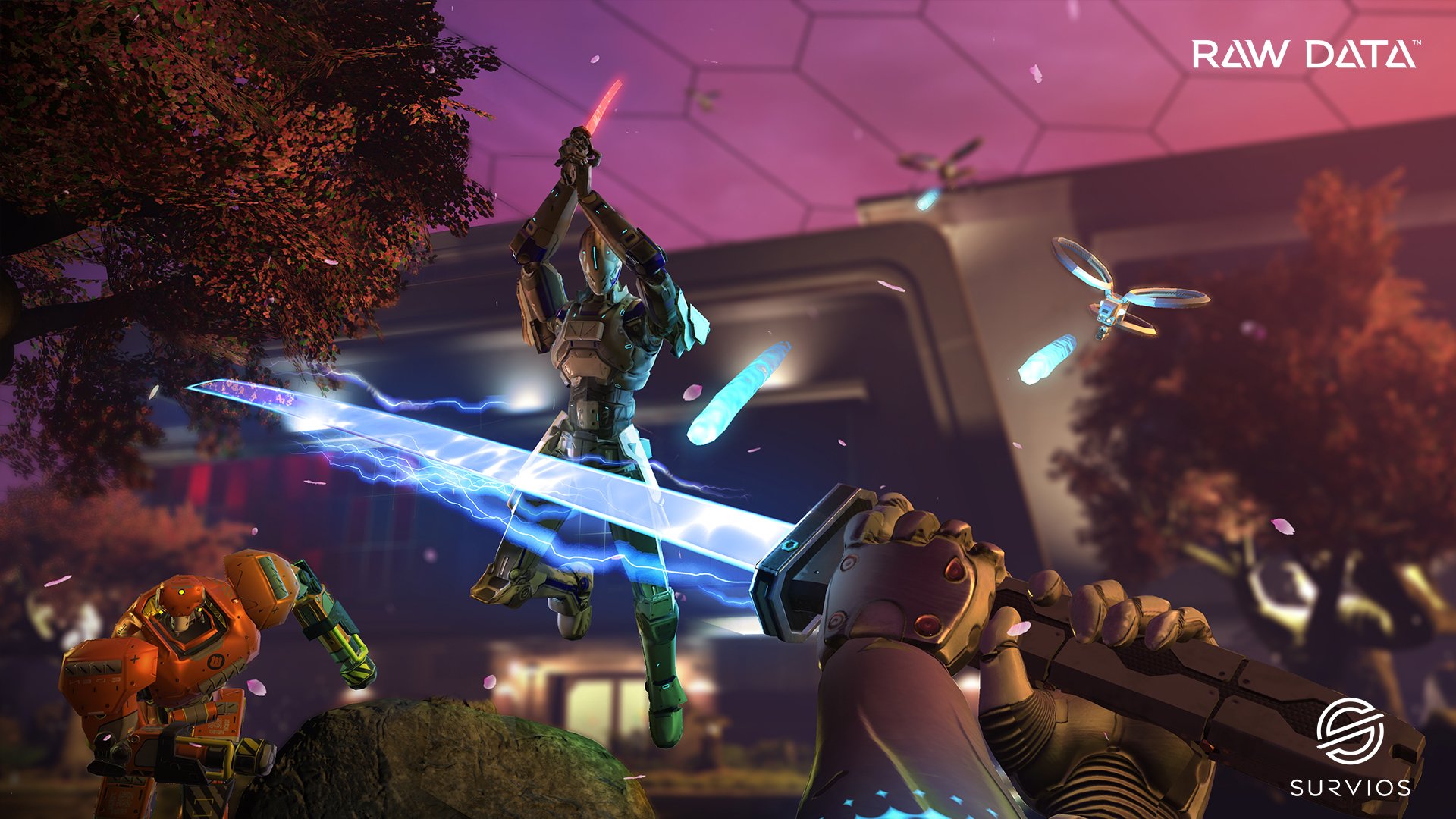
Survios is a five-year-old VR company. That doesn’t sound like much when you say it outloud, but considering that home-based consumer VR is only around three years old, it shows a certain knack for surviving as a studio while leveraging nascent technology that’s yet to garner mainstream appeal. The LA-based developers have put out four titles so far — Raw Data, Sprint Vector, Electronauts and just recently, Creed: Rise to Glory — and with each successive title the group has learned more and more about what makes VR and its players tick.
Raw Data, released in 2016, was Survios’ first hit and is still the studio’s flagship title. It was actually one of the earliest VR success stories, having generated $1 million within a few months of going on sale. At a time when VR was flooded with glorified tech demos, players were relieved to finally have some premium content to experience.
Raw Data is a pretty intense VR shooter… actually too intense for most. Surprisingly, Survios has discovered that a large segment of the VR audience isn’t that hardcore.
“Some of the big things we’ve learned in how we’re adapting to the market is our initial findings [were off base],” Mike McTyre, Head of Studio for Survios, told GameDaily.
“What we initially thought the market was [ended up being wrong], and specifically what they were looking for and what people would enjoy. We started with Raw Data, and we were right about some things and we were wrong about some things. And luckily enough we have enough of a backing and enough of the great talent at the studio that we’re able to adapt to the market as we’re learning about who the customers are.
“That’s really been a big part of our success is not trying to force the market to think a certain way, but rather to acknowledge the market and adapt to it. And to be aware of who are the people who are super excited about VR and who are the customers.”

The balance between immersion, difficulty and pure enjoyment is a fine line to tread, and Survios knew it had to react accordingly.
“With Raw Data we were more focused on more of the hardcore gamer at that time,” McTyre continued. “And you could see that in certain mechanics of the game where we have four different character classes in the game, we have a lengthy progression system with abilities, we use quite a significant number of powers and buttons. And even things just as complicated when you’re out of ammo having to reload the clip manually to the bottom of the gun. While we very much enjoyed that as a studio, there are many lessons like that where we learned that while there are some very vocal enthusiasts out there who do want more of that hardcore experience, we realized that a vast majority of the consumers are not hardcore gamers. They are just either what we would consider gamers or casual gamers. So you could see with that progression from Raw Data to Sprint Vector, we definitely made the product more streamlined.”
But how could consumers spending thousands on a high-end PC gaming rig and VR headset not be considered hardcore? Even a lower-cost PS4 combined with PSVR isn’t exactly cheap. McTyre has been just as surprised as anyone else.
“We know for a fact it’s not hardcore at this point,” he said. “And we made the exact same assumption that you and probably the vast majority of people out there have made. We assumed because the barrier was a little high that that meant they must be hardcore gamers. And again, are there hardcore gamers in VR? Absolutely. There definitely are. But are the vast majority of players hardcore? No they’re not.
“And here’s one simple example. When we first released Raw Data, it had 10 missions going through the campaign itself. We tuned all those missions and when we released it internally, we thought, ‘Okay. We’ll see how this does. The missions, they’re kind of easy to get through.’ We thought the game isn’t that hard. So we specifically added difficulty settings so that there was a hard and then a nightmare mode.
“But then, when we released it and we went through a bunch of the statistics… 80% of consumers could not get past mission one. And so, we actually ended up having to nerf Raw Data, the difficulty of the game, about four times, to make sure the vast majority of users got at least through mission six before they started to have a problem completing the missions. Again, we have many, many, other examples for that, but I think that one example really kind of hits the nail on the head, if you will, explaining that just because there’s a barrier of entry does not mean that it is hardcore gamers.”

While there is some overlap with the traditional PC/console crowd that will play the newest triple-A games for hours at a time, McTyre believes they are mostly separate audiences.
“These are people who love VR. These are people who want to be part of this next revolution,” he added. “People who want to interact with this new medium and experience products that they’ve never experienced before. But they are definitely not, the vast majority of them, those people who are playing Call of Duty 40 hours a week. Or going on hardcore raids in MMOs or any of that. Those users are still doing that. They’re not necessarily in VR. So it’s a different community than what most people had thought.”
If the audiences are that different, you might expect that the markets are too. And that’s precisely what McTyre noted. VR is so young and you continue to see new people coming into it, so games that would be considered “catalogue” in the console business can thrive two years later in VR.
“Raw Data‘s still doing very well,” McTyre confirmed. “There are still so many new people coming to VR who have never played before who are picking it up. And then they go online or ask their friends what do they recommend and still so many people are recommending Raw Data. And if you’ve never played VR, it’s not old to you. It’s a brand new thing. And it’s still an amazing experience for new users.
“That being said, Raw Data was a much, much larger product than Sprint Vector or Electronauts, in terms of the scope of the project and the sheer content in it. Raw Data certainly has performed more than the others, but we’re still very happy with how Sprint Vector and Electronauts are performing. I think one of the most interesting things, to my earlier point, is it’s not kind of the traditional console or PC market. In a sense where you release your game and it’s kind of ‘one and done,’ and you’ve kind of had your first month, your first three months, and that really is the vast majority of the sales of the product and then users move on to the next thing. That’s not true in the VR space.”
He continued, “I think this goes back to understanding the market. It’s growing constantly, so the lifespan of revenue for products is significantly longer than anything we traditionally see in console or PC space, for non-service type things.”
While most VR developers rely on digital storefronts, Survios will also benefit from a physical push from Sony for its newest game, Creed.
“The team has done a phenomenal job with this, we’re really excited about it. And with all of our partnerships with Sony, this is the first time where we’re going to have physical discs for Creed out there,” McTyre enthused. “And we’re going to be part of the PSVR bundles. We are really excited to see what this partnership with Sony brings, what kind of doors and opportunities this will present for the product.”
Survios has taken a very deliberate approach to VR development, honing in on a specific mechanic to polish with each game. With Sprint Vector it was a new kind of locomotion, and with Creed, it’s all about making punches feel real. Survios has the luxury of being able to put a good amount of R&D into its VR projects.
“A big focus for us is always about innovation,” McTyre stressed. “Every product we release, it’s not just for us. A lot of the conversations start for us internally not as, ‘What would be a cool game to make?’ but ‘What is a really cool mechanic or innovation to VR that hasn’t been done yet or that we could take a step further?’ And once we’ve identified that, that’s when we start crafting the game around that. And the biggest difference between then vs now in us adapting to the market is realizing that the consumers absolutely want quality experiences.
“And to that end, they don’t necessarily want tons of level of complexity… Creed brings that new level of innovation where we’re really focused just on solving melee in VR. Just making hitting things and getting hit feel incredible. And that took a lot of effort. When we first implemented it, you had to actually hold the trigger button down in order to punch. To clench your fists so it actually connected. And then again, this is a classic example of us realizing that might be great for hardcore gamers but the reality is, there’s no reason for that button. There’s no reason to have to hold the trigger down. So we just removed that and it’s just a better experience where you just are always in your clenched fist and you just have to punch.
“So there are hundreds of examples of that in our decision making process now that we better understand what the market is today. Again, we’re not going to change who’s purchasing VR, we need to make streamlined products for them. So they definitely want streamlined, not hardcore, products; but they want it to be premium products. That’s consistent across the board. Quality is something that they desire.”
As much as developers continue to fine tune the “language of VR,” players are learning more about what VR interactions should look like, feel like, and what generally feels right. It’s an education process on both sides as this young medium matures.
“Is there a point in time where you can have very complex, deep, and detailed games like Ready Player One where you have this massive MMO world where everyone’s game and all these systems all work simultaneously? The answer is absolutely. There’s no question that that’s going to happen,” McTyre said. “But for right now… there’s not 500 million people out there [and] we’re teaching players these mechanics too. No one’s really punched or felt what it’s like to punch before in VR until they played Creed. No one’s really locomoted like in Sprint Vector before playing that. It’s important that we really focus on that primary mechanic per product as to not overwhelm first time users and new users.
“It’s not like when there are decades of people using a PlayStation controller and knowing and having all the buttons memorized and knowing where everything is, and that doesn’t exist in VR. Again, that’s acknowledging the market and making these decisions based upon what’s going to make a great user experience, both for people who have a bunch of VR games, who have never played Raw Data and Sprint Vector, but also for first time users.”
Unlike a lot of other VR studios, Survios has its own arcade business as well. For each game the company brings to market, it also creates an arcade version. The studio has more than 100 employees now and keeps its business fairly diversified.
“Survios does a lot of things beyond just games,” McTyre noted. “We have a marketing team, we have distribution team, we have other different divisions focusing on a lot of different products. We also have our own VR arcade, owned and operated. So that’s been really successful. We’re really happy about that.
“The one thing that’s consistent with us is all of our efforts are geared towards VR in every capacity. But we have a very holistic view and holistic approach that we’re not just focused on one element of VR. We’re not just focused on games. [And] we have multiple projects in development. I’m not sure any other VR developer out there has that. So we are very fortunate, we’re keeping ourselves quite busy.”
The VR arcade scene is starting to grow a bit more in Western markets, as HTC Viveport President Rikard Steiber told us, but the demographic is fairly different from the home VR scene. McTyre has seen the home demographic skewing primarily male whereas in the arcades, it’s about 50/50 on gender. “But beyond that the demographs and their desires are very, very similar,” he said.
The biggest thing that VR developers should be aware of when it comes to the arcade is how social it is.
“We’re actually finding the vast majority of people going to arcades, they’re not going by themselves,” McTyre said. “The vast majority of people going to arcades are going in groups of three to four people. You might have a VR set up at your home, but maybe your friends don’t. That’s actually more common than not, we’re finding. So the best way to play four players in VR or three players in VR is to go to an arcade.”
Like Funomena, Survios believes in AR as well, even if it remains focused on VR currently. The studio just wants to ensure it’s properly aligned for growth with AR/VR in general. McTyre could not be more optimistic.
“All we see across the board is growth,” he remarked. “Growth and expansion and further investment in VR. And there are amazing things coming, which is why we keep focusing on making amazing content.”
He’s not dissuaded by the slow market ramp-up we’ve seen to date. It’s par for the course with new technology.
“All the signs are pointing towards VR being a huge part of not just gamers’ lives, but everybody’s lives at some point. The technology just needs to progress a little bit further. And that’s going to happen… There is still so much unexplored territory. We have really just started scratching the surface,” he said.
“If you just think about when TV first came out as a medium, there was only a handful of stations, and there was only broadcasting for so many hours. And not everybody had a TV in their house, let alone multiple TVs. And now, pretty much every household in the planet has one television set, if not multiple television sets in incredible high-def, 4k, LED. They have them mounted on their walls, and there’s literally more TV content than any human can ever consume. But that didn’t happen within the first year. That took time. VR is absolutely going to get there.”
 GameDaily.biz © 2025 | All Rights Reserved.
GameDaily.biz © 2025 | All Rights Reserved.